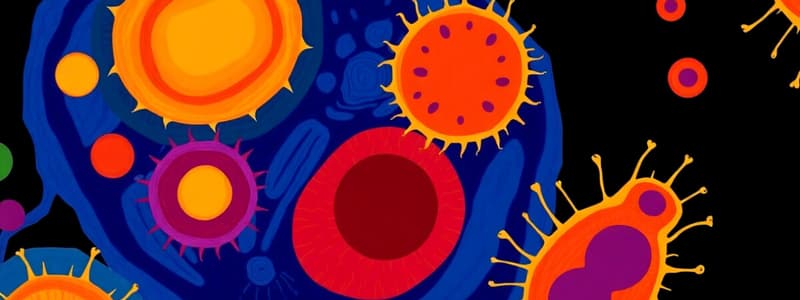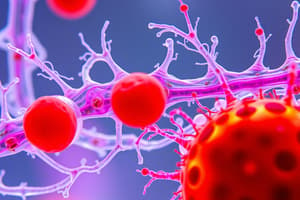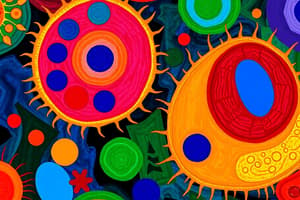Podcast
Questions and Answers
Which characteristic is exclusive to multicellular organisms but never present in unicellular organisms?
Which characteristic is exclusive to multicellular organisms but never present in unicellular organisms?
- Ability to reproduce
- Organization into tissues and organs (correct)
- Capacity to perform metabolic processes
- Response to external stimuli
How do fungi obtain nutrients differently from plants?
How do fungi obtain nutrients differently from plants?
- Fungi produce their own food through photosynthesis.
- Fungi synthesize nutrients from inorganic compounds.
- Fungi consume other living organisms.
- Fungi absorb nutrients from dead or decaying matter. (correct)
Which of the following best describes how cells work together?
Which of the following best describes how cells work together?
- Cells function independently without any interaction.
- Cells of different organisms always cooperate for survival.
- Cells organize to carry out life precesses (correct)
- Cells compete for resources.
Which of the following is an example of a vertebrate?
Which of the following is an example of a vertebrate?
In what way are plants and animals similar?
In what way are plants and animals similar?
Which of the following describes the main way that plants obtain food?
Which of the following describes the main way that plants obtain food?
Why are most unicellular organisms studied using a microscope?
Why are most unicellular organisms studied using a microscope?
If a new organism is discovered that lacks a backbone and cannot perform photosynthesis, how would it be classified?
If a new organism is discovered that lacks a backbone and cannot perform photosynthesis, how would it be classified?
What is the primary function of pseudopods in amoeba?
What is the primary function of pseudopods in amoeba?
How do amoeba digest food after capturing it via phagocytosis?
How do amoeba digest food after capturing it via phagocytosis?
How does gas exchange occur in unicellular organisms?
How does gas exchange occur in unicellular organisms?
Why is the ability of yeast to survive without oxygen useful in various industries?
Why is the ability of yeast to survive without oxygen useful in various industries?
How do unicellular organisms respond to their environment, given they lack complex sensory organs?
How do unicellular organisms respond to their environment, given they lack complex sensory organs?
How does 'movement' differ from 'locomotion' in unicellular organisms?
How does 'movement' differ from 'locomotion' in unicellular organisms?
Which of the following best illustrates 'movement' in unicellular organisms?
Which of the following best illustrates 'movement' in unicellular organisms?
How does exocytosis helps the amoeba?
How does exocytosis helps the amoeba?
What is a key advantage of observing live paramecia under a microscope compared to prepared slides?
What is a key advantage of observing live paramecia under a microscope compared to prepared slides?
What is a drawback of using live paramecia for microscopic observation?
What is a drawback of using live paramecia for microscopic observation?
How does cell specialization contribute to the complexity of multicellular organisms?
How does cell specialization contribute to the complexity of multicellular organisms?
Which of the following best describes the relationship between tissues, organs, and organ systems in multicellular organisms?
Which of the following best describes the relationship between tissues, organs, and organ systems in multicellular organisms?
Why is the differentiation of cells essential for the development of multicellular organisms?
Why is the differentiation of cells essential for the development of multicellular organisms?
Epithelial tissue is found...
Epithelial tissue is found...
Skin is an organ comprised of...
Skin is an organ comprised of...
How do plant tissues differ based on their primary function?
How do plant tissues differ based on their primary function?
If the respiratory system is not functioning efficiently, which of the following is the MOST likely direct consequence, according to the text?
If the respiratory system is not functioning efficiently, which of the following is the MOST likely direct consequence, according to the text?
Which of the following best describes how humans obtain nutrition based on the provided text?
Which of the following best describes how humans obtain nutrition based on the provided text?
In the human digestive system, what is the PRIMARY role of the stomach, as described in the text?
In the human digestive system, what is the PRIMARY role of the stomach, as described in the text?
How do nutrients absorbed in the intestine eventually reach other parts of the human body?
How do nutrients absorbed in the intestine eventually reach other parts of the human body?
Which structure in the earthworm digestive system is MOST analogous to the function of teeth in the human digestive system?
Which structure in the earthworm digestive system is MOST analogous to the function of teeth in the human digestive system?
What is the function of the crop in the earthworm's digestive system?
What is the function of the crop in the earthworm's digestive system?
Based on the information provided, how does the nutritional strategy of plants differ most significantly from that of animals?
Based on the information provided, how does the nutritional strategy of plants differ most significantly from that of animals?
Which of the following processes occurs in both human and earthworm digestive systems?
Which of the following processes occurs in both human and earthworm digestive systems?
What is the primary function of xylem vessels in plants?
What is the primary function of xylem vessels in plants?
Which process do plants use to create food using sunlight, carbon dioxide, and water?
Which process do plants use to create food using sunlight, carbon dioxide, and water?
In what form do plants store excess sugars that are produced during photosynthesis?
In what form do plants store excess sugars that are produced during photosynthesis?
What is the function of phloem vessels in plants?
What is the function of phloem vessels in plants?
How do earthworms obtain oxygen from their environment?
How do earthworms obtain oxygen from their environment?
What structures in the human respiratory system branch off into smaller tubes called bronchioles?
What structures in the human respiratory system branch off into smaller tubes called bronchioles?
In the human respiratory system, where does gas exchange primarily occur?
In the human respiratory system, where does gas exchange primarily occur?
What specialized structures do plants use for gas exchange?
What specialized structures do plants use for gas exchange?
How do earthworms move through the soil?
How do earthworms move through the soil?
Which of the following is NOT a typical role of unicellular organisms?
Which of the following is NOT a typical role of unicellular organisms?
What crucial role do fungi and bacteria play in the environment?
What crucial role do fungi and bacteria play in the environment?
How do some bacteria contribute to plant health?
How do some bacteria contribute to plant health?
What is the role of yeast in the food industry?
What is the role of yeast in the food industry?
How does penicillin, an antibiotic, originate?
How does penicillin, an antibiotic, originate?
In type 1 diabetes, what is the primary malfunction?
In type 1 diabetes, what is the primary malfunction?
How do people with type 2 diabetes typically manage their condition?
How do people with type 2 diabetes typically manage their condition?
Flashcards
Organism
Organism
A living system composed of smaller parts working together.
Unicellular organism
Unicellular organism
An organism made up of a single cell.
Multicellular organism
Multicellular organism
An organism composed of many cells working together.
Vertebrate
Vertebrate
Signup and view all the flashcards
Invertebrate
Invertebrate
Signup and view all the flashcards
Fungi
Fungi
Signup and view all the flashcards
Cellular differentiation
Cellular differentiation
Signup and view all the flashcards
Tissue
Tissue
Signup and view all the flashcards
Amoeba
Amoeba
Signup and view all the flashcards
Phagocytosis
Phagocytosis
Signup and view all the flashcards
Food Vacuole
Food Vacuole
Signup and view all the flashcards
Exocytosis
Exocytosis
Signup and view all the flashcards
Gas Exchange
Gas Exchange
Signup and view all the flashcards
Diffusion
Diffusion
Signup and view all the flashcards
Sensory Response
Sensory Response
Signup and view all the flashcards
Locomotion
Locomotion
Signup and view all the flashcards
Circulatory system
Circulatory system
Signup and view all the flashcards
Respiratory system
Respiratory system
Signup and view all the flashcards
Digestive system
Digestive system
Signup and view all the flashcards
Undigested food
Undigested food
Signup and view all the flashcards
Nutrition in humans
Nutrition in humans
Signup and view all the flashcards
Earthworm digestion
Earthworm digestion
Signup and view all the flashcards
Plants' nutrition
Plants' nutrition
Signup and view all the flashcards
Energy from nutrients
Energy from nutrients
Signup and view all the flashcards
Xylem vessels
Xylem vessels
Signup and view all the flashcards
Phloem vessels
Phloem vessels
Signup and view all the flashcards
Photosynthesis
Photosynthesis
Signup and view all the flashcards
Gas exchange in humans
Gas exchange in humans
Signup and view all the flashcards
Alveoli
Alveoli
Signup and view all the flashcards
Stomates
Stomates
Signup and view all the flashcards
Bronchioles
Bronchioles
Signup and view all the flashcards
Live Paramecia
Live Paramecia
Signup and view all the flashcards
Prepared Paramecia
Prepared Paramecia
Signup and view all the flashcards
Benefits of Live Slides
Benefits of Live Slides
Signup and view all the flashcards
Drawbacks of Live Slides
Drawbacks of Live Slides
Signup and view all the flashcards
Organ
Organ
Signup and view all the flashcards
Organ Systems
Organ Systems
Signup and view all the flashcards
Earthworm Movement
Earthworm Movement
Signup and view all the flashcards
Role of Unicellular Organisms
Role of Unicellular Organisms
Signup and view all the flashcards
Decomposers
Decomposers
Signup and view all the flashcards
Nitrogen Fixation
Nitrogen Fixation
Signup and view all the flashcards
Effects of Diabetes
Effects of Diabetes
Signup and view all the flashcards
Type 1 Diabetes
Type 1 Diabetes
Signup and view all the flashcards
Type 2 Diabetes
Type 2 Diabetes
Signup and view all the flashcards
Antibiotics from Micro-organisms
Antibiotics from Micro-organisms
Signup and view all the flashcards
Study Notes
Unicellular Organisms
- Unicellular organisms are living things composed of a single cell
- They perform all life functions within that single cell
- Examples include bacteria, protists, and some fungi
Multicellular Organisms
- Made up of many cells
- Cells are organized into tissues, organs, and organ systems
- Cells perform specialized functions within the organism
Organ Systems
- Groups of organs working together to perform specific tasks
- Examples include circulatory, respiratory, digestive, musculoskeletal, and nervous systems (in humans)
- Specialized functions from different parts of a system, e.g., the circulatory system transports materials, and the respiratory system exchanges gases
Cellular Differentiation
- Process where cells become specialized to perform a specific function
- Leads to the development of cells with different shapes and structures
- Important for multicellular organisms that need diverse tasks
Tissues, Organs, and Organ Systems
- Cells organized in groups based on structure and function
- Groups of similar cells form tissues
- Tissues combine to form organs
- Multiple organs working together form organ systems
- Tissues, organs, and organ systems all work together for well-being of the organism
Nutrition
- Animals must consume food from other organisms or their products
- Food needs to be broken down into smaller parts (nutrients) that can be used
- Humans have a complex digestive system to break down food
Plants
- Obtain most nutrients directly from the environment
- Xylem vessels and phloem vessels help transport water and nutrients
- Photosynthesis: plants use sunlight to make food from water, carbon dioxide
- Excess sugars used for storage
Gas Exchange
- Multicellular organisms need to exchange gases—oxygen and carbon dioxide
- Oxygen delivered to cells for energy
- Carbon dioxide removed from cells as a byproduct
- This process happens in different ways in various organisms (e.g., lungs, skin)
Responding to the Environment
- Organisms respond to factors in their environment
- This happens through a nervous system that sends signals, leading to a response.
Studying That Suits You
Use AI to generate personalized quizzes and flashcards to suit your learning preferences.




